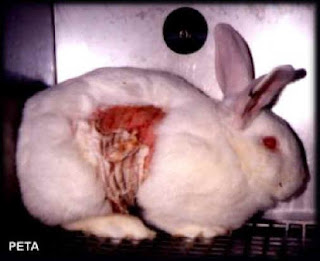

It may come from a sheep, goat, or Tibetan antelope. It may be called "wool," "mohair," "pashmina," or "cashmere." But no matter what you call it, it means bad news for the animal it came from. In the wool industry, just weeks after birth, lambs' ears are punched, their tails are chopped off, and the males are castrated, all without anesthetics. To prevent "flystrike" (a maggot infestation caused by wrinkly skin, which was bred into the sheep so that they would have more wool), Australian ranchers perform a barbarous operation called "mulesing," which involves carving huge strips of flesh off the backs of unanesthetized lambs' legs. [SaveTheSheet.com]

Leather
Leather is not a slaughterhouse byproduct. It's a booming industry, a driving force for the cattle industry, and it accounts for two-thirds of the value of the slaughtered cattle. Even the hides of "veal" calves are made into high-priced calfskin. The economic success of slaughterhouses and factory farms is directly linked to the sale of leather goods. Decreasing demand for both animal foods and leather products will result in fewer cows' being factory-farmed. To learn more about leather. [CowsAreCool.com]
 Fur
FurThose who wear fur trim and fur coats have the blood of minks, raccoons, foxes, beavers, and other animals on their hands. Animals on fur farms spend their lives in tiny cages only to be killed by anal or genital electrocution, which causes them to have a heart attack. Some are skinned alive. Animals in the wild may languish for days in traps before they die or are killed. [FurIsDead.com]
Have you ever wondered how many animals suffer in labs? It's a good question. Because there are so many animals in laboratories and records are not kept for all animals, estimates of the number of animals tortured and killed annually in U.S. laboratories vary widely but are in the millions.
The Animal Welfare Act requires laboratories to report the number of animals used in experiments, but it does not cover mice, rats, and birds (used in some 80 to 95 percent of all experiments). Because these animals are not covered by the act, they remain uncounted, and we can only guess at how many actually suffer and die each year.
Many household products and cosmetics companies still pump their products into animals' stomachs, rub them onto their skin, squirt them into their eyes, or force animals to inhale them as aerosol sprays. Charities such as the March of Dimes use donations from private citizens to fund experiments on animals, and the FDA requires all drugs to be tested on animals. However, animals differ from humans significantly, making animal drug tests unreliable and dangerous. New research methods, such as computer models, cell cultures, and human studies are more accurate, less expensive, and much more humane.
_____________________________________________________
i am not posting this to just make you feel bad. i's not posting it to say that your a horrible person because you don't care, or try to help. i am not posting this to do anything but inform you. if you want to know about it, then read. if you don't then ignore. it is your choice, it just makes me so sad, so i just want to tell people who don't know and who want to. people may not like PETA, they may make fun of it, say its stupid, or what have you. but i believe they're trying to change things, and i believe that those things need to be changed. Again, it's just my opinion. <3
- http://www.peta.org/actioncenter/entertainment.asp


No comments:
Post a Comment